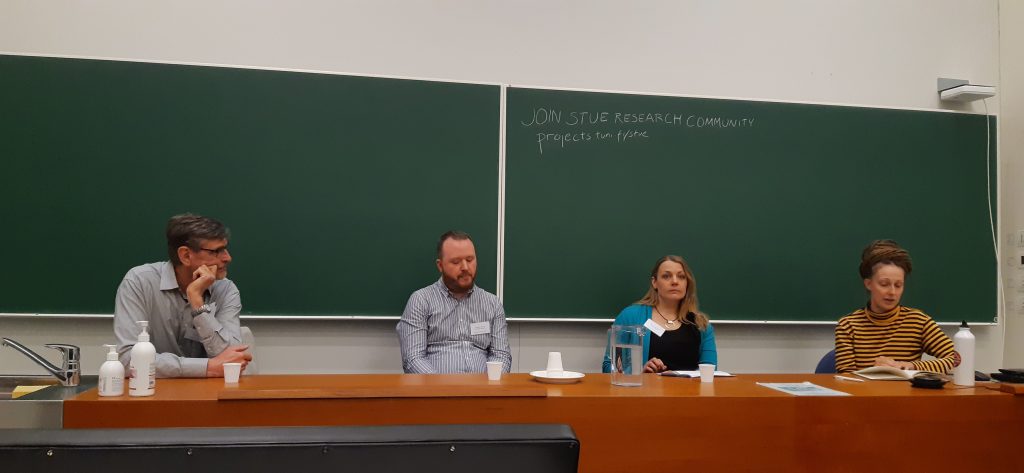
Urban studies is a multidisciplinary field that combines concepts, theories and research methods from social sciences, geography, history, architecture, economics, and many other disciplines. Therefore, the Finnish Urban Studies Conference, held in Tampere on April 28-29, 2020, was a natural setting for holding a panel discussion on inter- and multidisciplinary. The theme of the conference was Sustainable cities, which pointed to a transformation that requires systems thinking, as well as combining the perspectives of multiple disciplines. As a first-year student of sustainable urban development, I got a lot of food for thought from the discussion.
The panel discussion, named Devils in the detail? Inter-/multidisciplinary and nasty questions of priorities in urban sustainability research, took place on April 28, and rounded around strengths and challenges of coworking with people from different academic backgrounds. The chair of the discussion was Ilona Stailer, a postdoctoral research fellow in Sustainable Transformation of Urban Environments, STUE, which is research group in Tampere University. Each of the three panellists, Jonathon Taylor, a tenure track Associate Professor in Urban Physics in the Department of Civil Engineering at Tampere University, Juha Helenius, a professor in agroecology in University of Helsinki, and Nina Tynkkynen, a professor in Environmental Governance and Policy at Åbo Akademi University, have strong experience in working in an interdisciplinary environment. For example, Jonathon Taylor leads a technology stream in an interdisciplinary bachelor’s degree, Sustainable Urban Development, and has collaborated with professionals in various fields. Juha Helenius is leading multiple interdisciplinary research groups, such as a group studying sustainable food systems in Ruralia Institute of the Helsinki University. Nina Tynkkynen is currently leading one of the key research areas in Åbo Akademi, The Sea, which aims to solve marine-related sustainable issues in an interdisciplinary way. It became clear that questions on sustainability must be approached with a variety of methods and viewpoints. But how inclusive a field is urban studies really?
One panellist, Juha Helenius, has a background in agroecology, and it was especially him who expressed a worry of what is included in urban studies, and what is not, and how this will develop in the future. This question is not only relevant in an academic context but comes back to the essential questions on our worldview. Helenius was worried that we look at cities as if they were islands, without recognising all the connections and dependencies they have on their wider environment and rural areas. As a key example he provided the issue of food. According to him, food has not been given enough attention in urban research, considering that urban development depends on solving the problem of how to feed people in cities. Food production is first and foremost seen as a rural issue, excluded from cities.
This discussion made me think whether urban studies have become even too city-centred, especially when talking about sustainability. Seeing cities as islands creates an image that urban studies is a bubble, inside which multiple disciplines interact and overlap, but the bubble just floats on the world without connecting to the environment outside it. Inside the bubble, urban research and theories make sense, because they form their own city-cantered world. However, without bursting the bubble, the potential of urban studies to solve sustainability issues remains slight. Jonathon Taylor said how it can sometimes be surprising for a researcher to realize how much knowledge and skills people outside the academia have. Keeping this potential of the world outside the university in mind can help preventing the bubbles to form, even if that is easy to forget when most of your colleagues are other researchers.
If cities are not islands separated from rural areas and one another, how should they be defined? During the students’ Wappu celebrations in Tampere, I encountered multiple thought-provoking discussions on our study program and cities in general with students from different study fields. One student wondered whether cities could be thought as ecosystems, and in my opinion, that is a clever metaphor as it acknowledges both city as an entity and its dependency on the environment. It allows to find generalities in cities but also to see the unique traits of each city, to concentrate on the small and interesting details in urban life but also to recognise the connections between the city and its wider environment. Seeing cities as ecosystems could serve as a mediator in urban studies, as then city could become an interface that helps experts to come together and combine their knowledge. Even if they approach sustainability from different angles, city could be the factor that helps finding a common language. Nina Tynkkynen had experienced that only after multiple years of working together, the research group is starting to find its common language, as members have backgrounds in different fields and methodologies, and therefore even the same words can have different meanings. As finding a common language seems to be one of the trickiest parts in interdisciplinary research, every tool to ease that should be in use.
In addition to the strong division between urban and rural, another thing clouding the glory of urban studies as a multidisciplinary field and prevents it from being as inclusive as it could, is its concentration on certain types of cities. Based on my short experience as an urban development student, I have noticed that many of the most used theories are best applicable to wealthy cities in Europe and Northern America, or the theories are at least developed by studying mostly these cities. As a result, it is likely that current theories in urban studies are biased and therefore the possibilities to utilise them in solving real life problems, such as support fast growing cities all over the world, is limited.
Gladly, during the conference, I could notice that the trend might be changing. Even though the conference was held in Finland, the participants provided variety of viewpoints, not only concentrating on western cities. For example, one of the main keynote lecturers, Professor Visanthie Sewpaul, came from South Africa and concentrated on the city of Durban in her speech. Overall, urban studies is a developing field and, in my opinion, it is better to keep it like that. Even if it is good to clarify some concepts and try to find a common language within the field, the goal should not be to form a tightly defined discipline. I would like to see urban studies as a meeting place for people interested in cities and their relations to the wider world, no matter what disciplines the people represent.
In fact, the panellists discussed that it is beneficial to have a strong background in one discipline, to have so called disciplinary expertise, and then enter to a multidisciplinary group through one discipline. In this way, you can bring a lot to a group as well as learn new ways of thinking from others. To do multidisciplinary work successfully, it is important not to diminish what other people in the group have to offer or think about one’s own discipline as a superior one, so that the strengths of each field and individual can be utilised. When it comes to urban studies, it is also important not to stick to the status quo, but to welcome new angles and let the field grow and change. The goal, after all, is to improve our understanding of the world and be able to use this understanding to make the world a better place to live in. Excluding certain viewpoints is a disadvantage as it is impossible to understand this complex world, let alone advance sustainable development, by relying on only a few perspectives.
To sum it up, the key idea that I took away from the panel discussion was that as cities are not islands, the study of cities should not become one either. Therefore, multidisciplinary work within the community of urban researchers is not transformative enough to solve global problems if it is not placed in the right context by collaborating with researchers outside urban studies and hearing people from outside the academia.
Veera Uusitalo
Veera is studying Sustainable Urban Development in an interdisciplinary bachelor’s programme at Tampere university. Attending the Urban Studies Conference as an assistant was one of the highlights of her first study year. In the summer, Veera wants to spend a lot of time in nature and recommends that for everyone.

